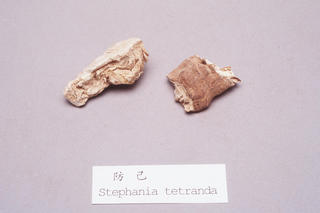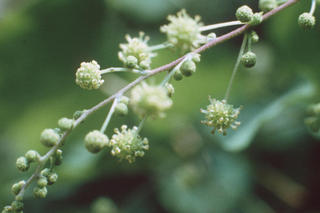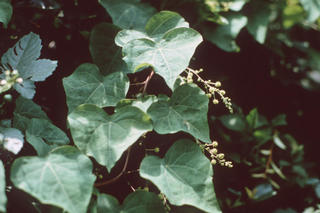Stephania tetrandra
Contents
Nomenclature
Other Names:
Historical Use of Stephania tetrandra
Stephania tetrandra in Traditional Chinese Medicine
Background
Hanfangji ºº·À¼º
Mufangji ľ·À¼º
Chinese Name (pinyin): Fangji
Chinese Name :
Common Name :Tetrandra Root
Specific Name : Radix stephaniae tetrandrae
Scientific Name:
Collection : The drug is collected in autumn, wash clean, removed from outer coarse bark, half dried in the sun, cut into section, the large one is cut longitudinally and dried.
Description : Irregular cylindrical, semi cylindrical or lump shaped, mostly tortous, 5 - 10 cm long, 1 - 5 cm in diameter. Externally greyish yellopw, usually exhibiting deeply depressed transverse grooves appearing as knotty knobby at the curved part. Texture heavy and compact, fracture even, greyish white, starchy, sparsely. Odour slight, taste bitter.
Identification : 1.Transverse section: Remaining cork sometimes visible. Cortex scattered with stone cells groups, usually arranged tangentially, phloem relatively broad. Cambium in a ring. The greater part occupied by xylem rays wide. Vessels rare, radially arranged, accompanied by wood fibres. Parenchymatous cells filled with starch granules and a few minute rod shape crystals of calcium oxalate.2.Heat about 2 g of the powder with 20 ml of sulfuric acid solution (0.5 mol/L) for 10 minutes and filter, adjust the filtrate to pH 9 By adding ammonia TS. Transfer to a separator and extract with 25 ml of benzene. Evaporate 5 ml of benzene extract to dryness and add several drops of molybdo-sulfuric acid TS to the residue, a violet color is produced which gradually becomes a green to dirty green colour and deepens on standing.3.Heat under reflux 1 g of the powder with 15 ml of ethanol for 1 hour, cool, filter and evaporate the filtrate to dryness. Dissolve the residue inb 5 ml of ethanol as the test solution. Dissolve tetrandrine CRS and fangchinoline CRS in chloroform to produce a mixture containing 1 mg of each per ml as the reference solution. Carry out the method for thin layer chromatography (Appendix l B) Using silica gel G as the coating substance and chloroform acetone-methanol (6:1:1) as the mobile phase. Apply separately to the plate 5µl of each of the two solutions. After developing and removal of the plate, dry it in the air and spray with dilute potassium iodobismuthate TS. The spots due to tetrandine and fangchinoline in the chromatogram obtained with the test solution correspond in position and colour with the spots in the chromatogram obtained with the reference solution.Assay: Weigh accurately about 1 g of the powder (through no. 3 sieve) previously dried at 80ºC for 4 hours to a Soxhlet's extractor, add 6 drops of concentrated ammonia solution, stand for 1 hour then add a quantity of chloroform and heat under reflux on a water bath for about 6 hours. After recovering of chloroform on a water bath, cool and dissolve the residue in absolute ethanol, transfer to a 2 ml volumetric flask, add absolute ethanol to volumn, mix well as the test solution. Dissolve tetrandine CRS in chloroform to produce a solution containing 2 mg of per ml as the reference solution. Carry out the method for thin layer chromatography (Appendix Vl B), using silica gel G as the coating substance and chloroform-acetone-methanol-concentrated ammonia (20:3:2:0.1) as the mobile phase. Apply accurately in strip to the plate 100 µl of the test solution and 10 µl of the test solution and 10 µl of the reference solution beside. After developing and removal of the plate, expose immediately under ultra violet light (365 nm) for about 10 minutes. Scrape off the strip of the test preparation corresponding in position with the reference spot, and scrape off equal area of silica gel G on the same plate as a blank. Packed to 2 column (0.7 cm x 10 cm). Carry out the method for column chromatography (Appendix Vl C), elute with 30 ml of methanol. Collect the eluate in an evaporating dish and evaporate to dryness on a water bath. Allow to cool, add accurately 10 ml of hydrochloric acid solution (0.1 mol/L) and dissolve the residue completely. Carry out the method for spectrophotometry (Appendix V A), measure the absorbance of the resulting solution at 280 nm. Calculate the content of C38H42N2O6, taking 113 as the value of A(1%, 1 cm). It contains not less than 0.7% of tetrandine (C38H42N2O6), calculate on the dried drug at 80ºC for 4 hours.
Processing : Eliminate foreign matter, soak briefly, wash clean, soften thoroughly, cut into thick slices and dry. Occurring in subrounded or broken thick slices, edges rather dark in colour, cut surface greyish white, starchy with sparse radial striations. Odour slight, taste bitter.
Action : To cause diuresis and to relieve rheumatic conditions.
Indication :
Precautions :
Dosage : 4.5 to 9 g.
Storage : Preserve in a dry place, protected from mould nd moth.
Synonymns for Stephania tetrandra
Patent Medicines and Medicines with Multiple Ingredients that include Stephania tetrandra
Pharmaceutical Information
Chemical Constituents
Evidence or the Use of Stephania tetrandra in the Treatment of Epilepesy
Basic Science
Animal Studies
Cohort, Case-Control and Non-Randomized Trials
Randomized Controlled Trials
Meta-Analysis
1st Five Results: pubmed search
Longfei Yang, Xiaonan Wang, Zhiming Ma, Yujie Sui, Xin Liu
Fangchinoline inhibits growth and biofilm of Candida albicans by inducing ROS overproduction.
J Cell Mol Med: 2024, 28(9);e18354
[PubMed:38686557]
[WorldCat.org]
[DOI]
(I p)
Jiawen Song, Yushi Liu, Yurou Guo, Minghao Yuan, Wenxiao Zhong, Jiamei Tang, Yiping Guo, Li Guo
Therapeutic effects of tetrandrine in inflammatory diseases: a comprehensive review.
Inflammopharmacology: 2024;
[PubMed:38568399]
[WorldCat.org]
[DOI]
(I a)
Li Fang, Rong Shen, Yao Lu, Xiangfeng Xu, Fang Huang
Tetrandrine alleviates inflammation and promotes macrophage M2 polarization in gouty arthritis by NF-κB-mediated Lcp1.
Cell Mol Biol (Noisy-le-grand): 2024, 70(2);205-211
[PubMed:38430024]
[WorldCat.org]
[DOI]
(I e)
Ruimin Ma, Xiaoxi Huang, Di Sun, Jingwei Wang, Changjiang Xue, Qiao Ye
Tetrandrine Alleviates Silica-induced Pulmonary Fibrosis Through PI3K/AKT Pathway: Network Pharmacology Investigation and Experimental Validation.
Inflammation: 2024;
[PubMed:38265677]
[WorldCat.org]
[DOI]
(I a)
Lilin Yi, Man Luo, Maoju Wang, Zhifang Dong, Yehong Du
Fangchinoline alleviates cognitive impairments through enhancing autophagy and mitigating oxidative stress in Alzheimer's disease models.
Front Cell Dev Biol: 2023, 11;1288506
[PubMed:38146492]
[WorldCat.org]
[DOI]
(P e)


